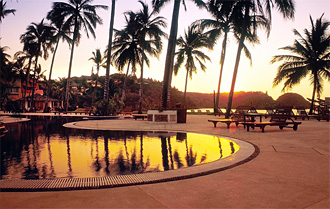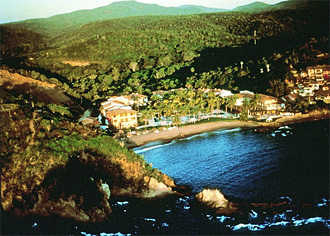
|
 |
 |
 Travel & Outdoors | June 2008 Travel & Outdoors | June 2008  
Resorts Deserve Their 'Luxury' Designations
 Patti Nickell - Herald-Leader Patti Nickell - Herald-Leader
go to original


| | The free-form pool at El Careyes Beach Resort commands breathtaking views of the Pacific Ocean, particularly at sunset. The area is a nesting ground for sea turtles. (El Careyes Beach Resort) | 
| | El Careyes Beach Resort sits in a secluded cove on the Pacific Ocean, surrounded by rainforest. (El Careyes Beach Resort) | | |

El Tamarindo and Costa Careyes, Mexico

El Tamarindo, with its authentic palapa casitas, seamlessly blends into the natural landscape of the jungle. The resort features 29 of these casitas in three categories forest, garden and beach - ranging in price from $625 for a forest casita to $3,250 for a two-bedroom beach casita suitable for four people. Prices are per night and include a variety of amenities. The resort also has a signature 18-hole golf course (with seven of the holes overlooking the Pacific Ocean), a beachside restaurant, a spa and activities such as horseback riding, scuba diving and polo. For reservations, call 1-866-717-4316 or go to ElTamarindoResort.com.

El Careyes Beach Resort, situated on an ecological preserve, is a hideaway for the discerning traveler. Its 48 rooms and suites and three casitas, which feature a rustic Mexican-Mediterranean folk-style decor, are priced at $305 to $1185 a night. Resort activities range from scuba and snorkeling excursions to deep-sea fishing. For reservations, go to ElCareyesResort. |
Jalisco, Mexico Getting robbed is never a good way to start a trip, but especially a trip that promised to be as idyllic as mine to El Tamarindo Resort on the tranquil Bay of Jalisco on Mexico's Pacific Coast. This was no ordinary robbery, however, as I was soon to find out. Returning to my casita after dinner the first night, I discovered not my passport, money or jewelry missing, but the contents of my mini-bar.

The cheese from my welcome tray had been picked through, packages of cookies had vanished, and the remains of a chocolate-dipped strawberry proved that the thief was persnickety in his food filching the dark chocolate had been devoured, but the strawberry lay in front of the open mini-bar like a splotch of blood, a blatant souvenir from my night prowler.

What to do? Should I call the front desk and let them know I had been victimized by a hungry hombre? Should I send for the policia? Or should I just be thankful that the thief was apparently a teetotaler and had expressed no interest in the pricey selection of liqueurs the resort had stocked?

Before I could make a decision, I came face to face with the rascal, a masked bandito who frequently preys on unwary resort guests. Standing about 2 feet tall, he stared insolently at me through the slits in the mask revealing his beady eyes, swished his considerable tail and disappeared into the tropical brush, a chocolate bon-bon protruding from his mouth. Truly a robber lacking a single shred of remorse.

As I was later to find out from housekeeping, coatis, raccoon-like creatures with rapacious appetites, are common here in the jungle. They have a sweet tooth. and if guests don't take proper precautions, they can find their mini-bar charges inflated by several thousand pesos.

Far from being menacing, the coatis are so adorable that I found myself purposely leaving the door to my mini-bar ajar in the hopes of luring my nocturnal visitor back.

Coatis aside, Tamarindo, nestled among 2,040 acres of tropical rainforest on the Pacific Ocean, 31 miles north of Manzanillo and 132 miles south of Puerto Vallarta, is perfect for those in search of luxurious solitude. The casitas some facing the beach, others nestled among groves of palm trees have outdoor living/dining areas, private plunge pools and Jacuzzis. A torch-lit trail through the jungle takes you to the beachfront restaurant La Higuera, named for the resort's 93-year-old fig tree (there also are two 300-year-old Cuban palms).

Two of El Tamarindo's most outstanding features are its spectacular golf course, ranked No. 2 in Mexico, and its rustic Spa Hut.

The former wends its way through lush vegetation and dramatic cliffs above the Pacific. Even if you're not a duffer, commandeer one of the carts and head up for lunch at Hole 9, a hilltop restaurant overlooking the greens and the sea below.

The latter, offering a full array of spa services in a bamboo palapa, is best known for its signature Temazcal, a 21/2-hour Indian ritual that allows participants to connect with the spirit of water, plants, air, earth and fire, while at the same time purifying the body.

From coatis to turtles

My second stop was at El Careyes Beach Resort, a 45-minute drive from Tamarindo on the beautiful Costa Careyes.

Costa Careyes is Spanish for Turtle Coast, so named because the beaches are a sanctuary and nesting ground for sea turtles. In 1968, Italian artist and visionary Gian Franco Brignone first laid eyes on the pristine coast and promptly proclaimed it heaven on Earth. Following in the footsteps of the Aga Khan, who, in the 1960s, developed the Costa Smeralda (Emerald Coast) on the Italian island of Sardinia as a playground for the jet set, Brignone set about creating an ideal resort.

He succeeded admirably. While preserving the natural landscape of cliffs and shoreline, he has developed a community of resort hotels, villas, shops and entertainment outlets. The most accessible of the hotel properties is El Careyes, a boutique hotel designed to resemble a Mexican pueblo. Its 48 rooms and suites form a horseshoe facing one of the Pacific coast's most spectacular bays.

The most dramatic of the properties is Mi Ojo (My Eye), a Brignone-designed gem atop a Careyes cliff, complete with an infinity pool and a hanging bridge connecting to a private island. Along with Brignone's two other architectural treasures, Sol de Oriente and Sol de Occidente, which face each other atop opposite cliffs, it makes up the Castles of Careyes (any of which can be yours for a mere $5,000 a night).

My time at El Careyes was spent leisurely strolling the beach, traipsing around Mi Ojo in jaw-dropping wonder (even summoning up the courage to venture across the hanging bridge, suspended between two cliffs at dizzying heights above the bay), and dining at the Polo Club with Gian Franco's charming son Georgio, who has inherited his father's passion for Careyes.

But by far my most e_SDHpmemorable experience was on my last morning, when I accompanied a marine biologist to Teopa Beach, a private reserve where sea turtle eggs are collected and hatched, and baby turtles are released back into the sea. I watched, and then, encouraged by the biologist, scooped up some of the tiny turtles, no bigger than a half-dollar in the palm of my hand, and helped them wriggle their way across the sand to disappear into the churning surf.

I remained on the beach until the last of the turtles was gone and the waves had erased all traces of their journey from the sand. I thought to myself that I couldn't ask for a better farewell to Mexico. | 
 | |
 |



